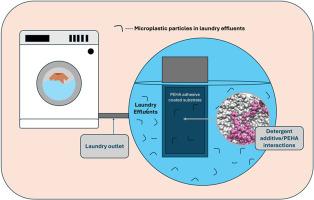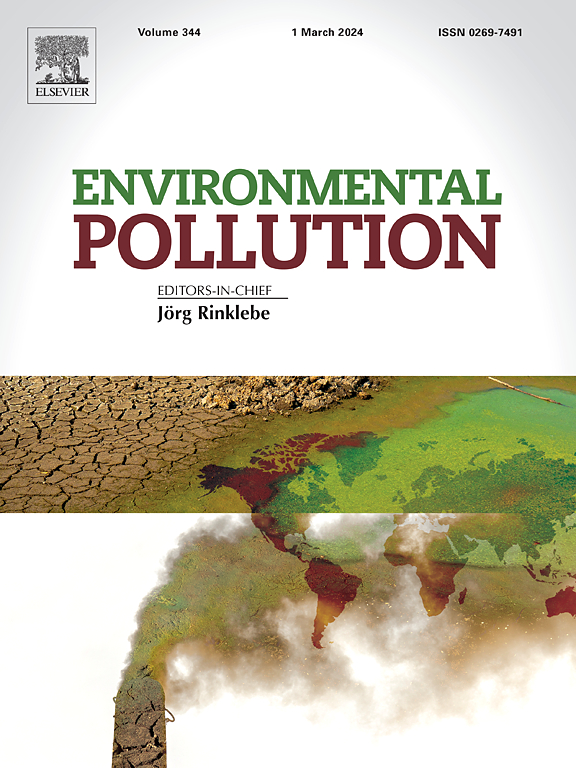Surfactants can compete with microplastics for surfaces using adhesives as substrates for microplastic sequestration
IF 7.3
2区 环境科学与生态学
Q1 ENVIRONMENTAL SCIENCES
引用次数: 0
Abstract
Experimental efforts supplemented by modeling gauged whether common additives found in soaps and laundry detergents interfered with polyacrylate adhesive-based capture of microplastics. On the experimental front, poly(2-ethylhexyl acrylate) (PEHA) samples were evaluated using gravimetric analysis, probe tack, and functional assessments of adhesive-coated glass slides immersed into DI water solutions containing both microparticles and additives (solvents, softeners, and non-ionic surfactants). Nylon-6 spheres and polyethylene terephthalate microplastics were chosen for adsorption using a count-based method by ImageJ imaging analysis. Molecular dynamics computations simulated 2-ethyl-hexylacrylate (2-EHA) adhesive and microplastic interactions in the presence of water, citrate, glycerol and tergitol detergent additives. The experimental work showed that fewer microplastics were collected when tergitol was added and was in line with lower experimental Work of Adhesion (WoAaq) results for nylon and PETE (94.5% and 54.5% reductions respectively). Computational results also confirmed lower adhesion in the presence of tergitol. The experiments also showed that the adhesive swelled while equilibrating in additive solutions. Models suggested that tergitol most negatively impacted particle binding through a competitive “blocking” of the adhesive substrate while the other additives were less conclusive about potential interferences based on competitive binding.


表面活性剂可与微塑料争夺使用粘合剂作为微塑料封存基质的表面
以实验为基础,辅以建模,评估肥皂和洗衣粉中常见的添加剂是否会干扰聚丙烯酸酯粘合剂对微塑料的捕捉。在实验方面,使用重力分析、探针粘性以及将涂有粘合剂的玻璃载玻片浸入含有微颗粒和添加剂(溶剂、软化剂和非离子表面活性剂)的去离子水溶液中进行功能评估,对聚(2-乙基己基丙烯酸酯)(PEHA)样品进行了评估。通过 ImageJ 成像分析,采用基于计数的方法选择尼龙-6 球和聚对苯二甲酸乙二酯微塑料进行吸附。分子动力学计算模拟了 2-乙基-己基丙烯酸酯(2-EHA)粘合剂和微塑料在水、柠檬酸盐、甘油和特立醇洗涤剂添加剂存在下的相互作用。实验结果表明,添加特立醇后,收集到的微塑料更少,这与尼龙和 PETE 较低的粘附功(WoAaq)实验结果一致(分别降低了 94.5% 和 54.5%)。计算结果也证实了有特立醇存在时粘附力较低。实验还表明,粘合剂在添加剂溶液中平衡时会膨胀。模型表明,松脂醇通过竞争性 "阻塞 "粘合剂基质对颗粒粘合力的负面影响最大,而其他添加剂对基于竞争性粘合力的潜在干扰的影响较小。
本文章由计算机程序翻译,如有差异,请以英文原文为准。
求助全文
约1分钟内获得全文
求助全文
来源期刊

Environmental Pollution
环境科学-环境科学
CiteScore
16.00
自引率
6.70%
发文量
2082
审稿时长
2.9 months
期刊介绍:
Environmental Pollution is an international peer-reviewed journal that publishes high-quality research papers and review articles covering all aspects of environmental pollution and its impacts on ecosystems and human health.
Subject areas include, but are not limited to:
• Sources and occurrences of pollutants that are clearly defined and measured in environmental compartments, food and food-related items, and human bodies;
• Interlinks between contaminant exposure and biological, ecological, and human health effects, including those of climate change;
• Contaminants of emerging concerns (including but not limited to antibiotic resistant microorganisms or genes, microplastics/nanoplastics, electronic wastes, light, and noise) and/or their biological, ecological, or human health effects;
• Laboratory and field studies on the remediation/mitigation of environmental pollution via new techniques and with clear links to biological, ecological, or human health effects;
• Modeling of pollution processes, patterns, or trends that is of clear environmental and/or human health interest;
• New techniques that measure and examine environmental occurrences, transport, behavior, and effects of pollutants within the environment or the laboratory, provided that they can be clearly used to address problems within regional or global environmental compartments.
 求助内容:
求助内容: 应助结果提醒方式:
应助结果提醒方式:


